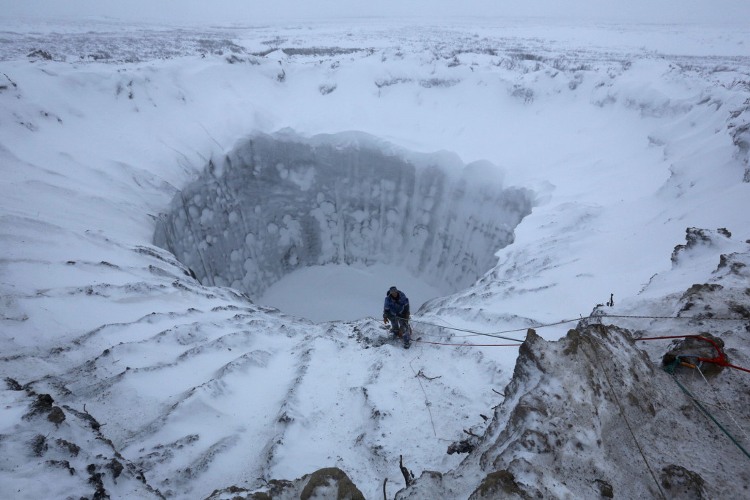Finding a giant pit in Siberia: The time bomb for our Earth has begun to run
The giant hole, also known as the " death " crater, with a diameter of nearly 31m, appeared on the Yamal Peninsula in a surprisingly dramatic way, during the period of escalating tension between the Russian army in Ukraine.
Next is the appearance of other giant pits in many northern regions. Due to the lack of authentic evidence, many people believe that this is the result of underground missile tests or aliens, according to the Washington Post.

Scientists are examining the giant crater at the North Pole.
In fact, behind those assumptions is a greater danger to the entire earth: climate change .
American scientists have stated in the report that ice melting in the far north is happening at an alarming rate. In the summer of 2014, heat was found to be 9 degrees Fahrenheit above the average temperature, reported in a Nature paper. According to scientists at the US National Oceanic and Atmospheric Center, the consequences of global warming are the phenomenon of permafrost on the northern tundra that are showing signs of melting.
So how can frozen methane gas make a giant hole with a diameter of 31m on the ground?
Under the effect of low temperature and high pressure, methane and water can coagulate at the same time and form a " flammable " mixture (Methane Hydrate). Permanent ice blocks sink everything to the bottom. However, when the ice blocks melt, the ice blocks melt along. The methane gas escapes as gas flows put pressure on the ground until the surface explodes.
Scientists have obtained new evidence for this hypothesis after surveying the bottom of the giant pit. The results show that the air in the pit bottom area has a high concentration of methane gas.
However, the concern is not only about explosions or the phenomenon of melting ice blocks permanently. The US Environmental Protection Agency has stressed that methane is a greenhouse gas that can affect up to 25 times the CO2 in a century.
In addition, methane gas is thought to cause serious effects on the earth's atmosphere as they are 21 times more likely to retain heat, according to Live Science.
 The dense occurrence of death holes is due to Earth's climate change.
The dense occurrence of death holes is due to Earth's climate change.
Many leaks have pushed beyond what we could imagine and this alarming issue could be considered a time bomb for the earth.
Not stopping there, things get serious when one of the 6 craters is only 10km from a natural gas station. The Siberian Times warns that when two flammable streams intersect, this will be a major safety concern for the region. At least 2 of the craters have become lakes.
However, there is another explanation for this problem. The ground can be subsided not only by the impact of burning when menthane. When ice is held between soil layers and deforms the surface layer, melting ice in the middle layer also causes landslides to form deep holes on the ground. This phenomenon is called " pingo ".
Although these pits are the result of pingo phenomenon , climate change is still a matter of concern and greatly affects the earth.
Slate pointed out that similar things can happen in Alakas.
Clearly, climate change is changing the status of the northern region with dizzying speed and faster than anywhere on earth. However, experts still do not have accurate studies of the impact of this unprecedented global warming on the southern polar ecosystem.
Mysterious Siberian wormholes can serve as a signal for the consequences of human-induced climate change. These changes will continue in the future at a higher level, difficult to control and predict.
- Secrets revealed under 'eternal time bomb' in Siberia
- Discover the second giant crater in Siberia
- The Siberia region begins to thaw
- 7,000 air bombs can create giant pits in Siberia
- Blizzard 'devour' Siberia city in the cold of -50 degrees Celsius
- The third mysterious crater in Siberia
- 'Earth's most terrifying time bomb' sprayed a giant column of hot water
- America tried to succeed in a giant gas bomb
- Electric waste like global time bomb
- The most powerful thermonuclear bombs in the world
- Meteors explode into night in Siberia
- The mysterious crater in Siberia houses a 25-storey building
 Is the magnetic North Pole shift dangerous to humanity?
Is the magnetic North Pole shift dangerous to humanity? Washington legalizes the recycling of human bodies into fertilizer
Washington legalizes the recycling of human bodies into fertilizer Lightning stone - the mysterious guest
Lightning stone - the mysterious guest Stunned by the mysterious sunset, strange appearance
Stunned by the mysterious sunset, strange appearance